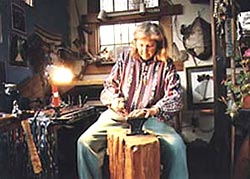Artist of the Elements: Lavelle Foos
 Lavelle Foos in her studio
Lavelle Foos in her studioPhotograph courtesy of Lavelle Foos
Beginning her artistic endeavors as a teacher of junior high and high school art and theatre in Los Aimitos, Southern California, copper artist and jewelry maker, Lavelle Foos found her connection to copper when she relocated from the Los Angeles area to Oregon.
"The sand turned to dirt before my eyes," she recalls. "I had the opportunity to make a shift so I took off."
Once in Ashland, Oregon, she became acquainted with a coppersmith who lived on a local Navajo reservation. Lavelle began to emotionally connect with the earth based copper element.
"He made his own tools and taught me to work with the simplicity and beauty of copper and the style of the Navajo work," Lavelle says. "Copper draws people to you. Silver can often move you away, because it's shiny and flashy. But copper is the divine feminine. It's also an anti-inflammatory and it's nurturing; everything moves by copper. Computers, electricity---it's all by copper wire. So the whole planet is running on this copper energy."
She views copper as "the metal from the Northwest" and certainly, copper is well entrenched in the area, having been mined here for over 100 years. Lavelle also uses materials like abalone, amber, cedar wood and even discarded antler horns to create spiritually sensitive sculpture and jewelry.
 Copper earring design by Lavelle Foos
Copper earring design by Lavelle Foos Photograph courtesy of Lavelle Foos
Currently living on the San Juan Islands near Seattle, she buys her 3 foot by 5 foot sheet copper from the Alaskan Copper and Brass Company, and Alaskan Copper Works, founded in 1913, located in Seattle.
"I use a torch or an electric hot plate on the copper until it turns black, then I dip it into an acid wash which takes the black off," she says, adding that at that point, it's like wax, soft and malleable, easy to bend and tool. "For the polishing, which I learned from a blacksmith, I heat it until I get the colors I want, then I use a paste wax while it's still hot and buff the wax in."
The copper won't turn anymore she says. For her copper jewelry, the necklaces and "shields," if they do discolor, a simple dip into vinegar or lemon juice will regenerate the color and take away the patina green. Lavelle also uses copper in her larger wood sculptures.
"I use 2,000 year old redwood, felled naturally by lightning, red cedar which is sustainably harvested, and yellow cedar from Alaska," she says. "Quartz crystal, antler, abalone shell: I have these elemental jewels, to keep alive the connection for a fast moving contemporary culture," she says. The natural elements, the "healing materials" of what nature has designed are to be used to, "help people know and love themselves more." Lavelle fully believes that the base elements of fire, earth, wind and water re-connect us to the world we once knew in more simple times.
Lavelle works closely with many galleries in her area, including San Juan Island Galleries, Dolphin Arts, and the Wescott Bay Institute Sculpture Park. Her work will be shown at the Summer Arts Fair on San Juan Island in July.
"When people see these materials, they want them, they don't know why, but it's in our DNA," says Foos. "People love to look at and feel copper."
Also in this Issue:
- Shedding Light on the Legacy of Tiffany
- Copper Lantern
- Artist of the Elements: Lavelle Foos
- Brookgreen Gardens: America's First Sculpture Garden
- Tiffany by Design on View at Frist
